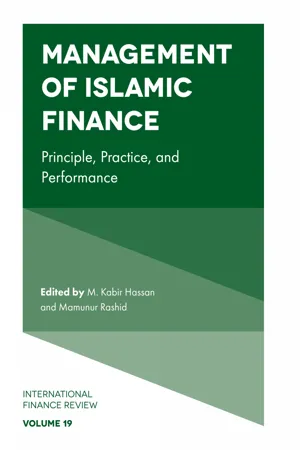
Management of Islamic Finance
Principle, Practice, and Performance
- 276 pages
- English
- ePUB (mobile friendly)
- Available on iOS & Android
Management of Islamic Finance
Principle, Practice, and Performance
About This Book
Islamic finance has emerged as an alternative to century-old conventional financial instruments to cater to cater to the needs of Muslims as well as non-Muslims. The industry has seen significant growth over the last two decades and has been facing omnidirectional challenges with respect to regulation, competition, and compatibility. These challenges have presented worthy debate on the principles, practices, and performance in Islamic finance globally. In this issue, we have presented issues relevant to the most recent debate on the performance, practices, and principles of the Islamic finance industry as a whole, covering eleven distinct issues. Authors have contributed to the existing body of knowledge on risk management in Islamic banks, diversification in Islamic equity markets, performance and acceptance of Islamic microcredit and Islamic banking services, long-term corporate finance using sukuk, and the social development agenda via the development of financial intuitions, SME financing, and financial inclusion. Selected topics cover the principles in relevant areas, focus on recent practices, and highlight performance on certain influential areas. The issue is aimed at academicians, researchers, and policymakers who are working in the Islamic finance industry and who would like to explore more.
Frequently asked questions
Information
CHAPTER 1
INVESTIGATING INTERNATIONAL PORTFOLIO DIVERSIFICATION OPPORTUNITIES FOR THE ASIAN ISLAMIC STOCK MARKET INVESTORS
ABSTRACT
1. INTRODUCTION
Table of contents
- Cover
- Title
- Chapter 1 Investigating International Portfolio Diversification Opportunities for the Asian Islamic Stock Market Investors
- Chapter 2 Islamic Banks’ Resilience to Systemic Risks: Myth or Reality-Evidence from Bangladesh
- Chapter 3 Satisfaction with Islamic Microcredit Institutions: A Borrower-Centric Approach
- Chapter 4 Religious Preference and Financial Inclusion: The Case for Islamic Finance
- Chapter 5 Post-Default Sukuk Restructuring: An Appraisal of Shari’ah Issues
- Chapter 6 Relevance of Development Financial Institutions in the Presence of Islamic Financial Institutions
- Chapter 7 Corporation’s Threshold for Debt: Implications for Policy Reforms toward Equity-Biased Corporate Tax System
- Chapter 8 “Reverse Mudarabah” An Alternative of Classical Mudarabah for Financing Small Businesses
- Chapter 9 Participating Mortgages: An Alternative to Housing Finance
- Chapter 10 Determinants of Customers’ Engagement with Islamic Banking
- Chapter 11 Political Islam, Democracy, and Islamic Finance Development
- Index